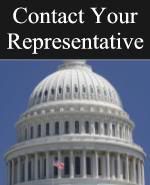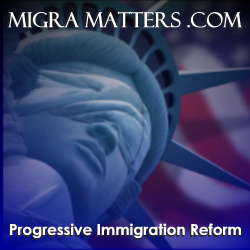The Immigration Equation: Summer reading for wonks
For the time being the immigration issue has moved from the front pages to be replaced by more pressing world affairs. Yet with both houses of Congress out on the road holding public hearings on the topic, it will only be a matter of time before the big wedge issue of 2006 returns. Looming large on the midterm election horizon, the debate over immigration reform has been the subject of numerous studies, polls and research papers, many of them highly partisan and of dubious academic merit. Recently the New York Times Magazine separated the wheat from the chaff when it published an article recapping the work done by leading labor economists on the issue.
While most look at the summer as a time to catch up on some light reading, something frivolous and entertaining; for the wonkish it's the perfect time to bone up on some solid academic research on immigration and it's real effects on our economy.
The Times article, "The Immigration Equation" is a great primer on the subject and looks at the two competing schools of thought of leading labor economists on immigration and how their work plays out in the current debate.
tags: immigration, George Borjas, David Card , economic studies, HR4437, S.2611 To Borjas, a Cuban immigrant and the pre-eminent scholar in his field, the truth is pretty obvious: immigrants hurt the economic prospects of the Americans they compete with. And now that the biggest contingent of immigrants are poorly educated Mexicans, they hurt poorer Americans, especially African-Americans, the most.
To Borjas, a Cuban immigrant and the pre-eminent scholar in his field, the truth is pretty obvious: immigrants hurt the economic prospects of the Americans they compete with. And now that the biggest contingent of immigrants are poorly educated Mexicans, they hurt poorer Americans, especially African-Americans, the most.
Borjas has been making this case — which is based on the familiar concept of supply and demand — for more than a decade. But the more elegantly he has made it, it seems, the less his colleagues concur. ‘‘I think I have proved it,’’ he eventually told me, admitting his frustration. ‘‘What I don’t understand is why people don't agree with me.''
It turns out that Borjas's seemingly self-evident premise — that more job seekers from abroad mean fewer opportunities, or lower wages, for native workers — is one of the most controversial ideas in labor economics. It lies at the heart of a national debate, which has been encapsulated (if not articulated) by two very different immigration bills: one, passed by the House of Representatives, which would toughen laws against undocumented workers and probably force many of them to leave the country; and one in the Senate, a measure that would let most of them stay.
You can find economists to substantiate the position of either chamber, but the consensus of most is that, on balance, immigration is good for the country. Immigrants provide scarce labor, which lowers prices in much the same way global trade does. And overall, the newcomers modestly raise Americans' per capita income. But the impact is unevenly distributed; people with means pay less for taxi rides and household help while the less-affluent command lower wages and probably pay more for rent.
The debate among economists is whether low-income workers are hurt a lot or just a little — and over what the answer implies for U.S. policy. If you believe Borjas, the answer is troubling. A policy designed with only Americans' economic well-being in mind would admit far fewer Mexicans, who now account for about 3 in 10 immigrants.
-snip-
Easily the most influential of Borjas's critics is David Card, a Canadian who teaches at Berkeley. He has said repeatedly that, from an economic standpoint, immigration is no big deal and that a lot of the opposition to it is most likely social or cultural. "If Mexicans were taller and whiter, it would probably be a lot easier to deal with," he says pointedly.
Economists in Card's camp tend to frame the issue as a puzzle — a great economic mystery because of its very success. The puzzle is this: how is the U.S. able to absorb its immigrants so easily?
After all, 21 million immigrants, about 15 percent of the labor force, hold jobs in the U.S., but the country has nothing close to that many unemployed. (The actual number is only seven million.) So the majority of immigrants can't literally have "taken" jobs; they must be doing jobs that wouldn't have existed had the immigrants not been here.
The economists who agree with Card also make an intuitive point, inevitably colored by their own experience. To the Israeli-born economist whose father lived through the Holocaust or the Italian who marvels at America's ability to integrate workers from around the world, America's diversity — its knack for synthesizing newly arrived parts into a more vibrant whole — is a secret of its strength.
-snip-
In a recent paper, "Is the New Immigration Really So Bad?" Card took indirect aim at Borjas and, once again, plumbed a labor-market surprise. Despite the recent onslaught of immigrants, he pointed out, U.S. cities still have fewer unskilled workers than they had in 1980. Immigrants may be depriving native dropouts of the scarcity value they might have enjoyed, but at least in a historical sense, unskilled labor is not in surplus. America has become so educated that immigrants merely mitigate some of the decline in the homegrown unskilled population. Thus, in 1980, 24 percent of the work force in metropolitan areas were dropouts; in 2000, only 18 percent were.
Card also observed that cities with more immigrants, like those in the Sun Belt close to the Mexican border, have a far higher proportion of dropouts. This has led to a weird unbalancing of local labor markets. For example, 10 percent of the work force in Pittsburgh and 15 percent in Cleveland are high-school dropouts; in Houston the figure is 25 percent, in Los Angeles, 30 percent. The immigrants aren't dispersing, or not very quickly.
So where do all the dropouts work? Los Angeles does have a lot of apparel manufacturers but not enough of such immigrant-intensive businesses to account for all of its unskilled workers. Studies also suggest that immigration is correlated with a slight increase in unemployment. But again, the effect is small. So the mystery is how cities absorb so many unskilled. Card's theory is that the same businesses operate differently when immigrants are present; they spend less on machines and more on labor. Still, he admitted, "We are left with the puzzle of explaining the remarkable flexibility of employment demand."
alternate link
The article also references other academic studies and reports and gives good historical background on the topic. It's a great starting point for acquiring a good understanding of current debate amongst social scientists in the field.
With all the hyperbole and partisan rhetoric passing for information in the immigration debate, this little lull in activity presents an ideal opportunity for those truly interested in immigration reform to bone up on some solid reality-based information.
For further reading see:
Is the New Immigration Really So Bad?
David Card, Department of Economics, UC Berkeley, January 2005
This paper reviews the recent evidence on U.S. immigration, focusing on two key questions: (1) Does immigration reduce the labor market opportunities of less-skilled natives? (2) Have immigrants who arrived after the 1965 Immigration Reform Act successfully assimilated?
Looking across major cities, differential immigrant inflows are strongly correlated with the relative supply of high school dropouts. Nevertheless, data from the 2000 Census shows that relative wages of native dropouts are uncorrelated with the relative supply of less-educated workers, as they were in earlier years. At the aggregate level, the wage gap between dropouts and high school graduates has remained nearly constant since 1980, despite supply pressure from immigration and the rise of other education-related wage gaps. Overall, evidence that immigrants have harmed the opportunities of less educated natives is scant. On the question of assimilation, the success of the U.S.-born children of immigrants is a key yardstick. By this metric, post-1965 immigrants are doing reasonably well: second generation sons and daughters have higher education and wages than the children of natives. Even children of the least educated immigrant origin groups have closed most of the education gap with the children of natives.
"The Impact of Immigration and the Labor Market" , George J. Borjas, Harvard University, January 2006
Not surprisingly, the impact of immigration on the host country’s labor market is now being heatedly debated in many countries. In the U.S. context, this concern has motivated a great deal of research that attempts to document how the U.S. labor market has adjusted to the largescale immigration of the past few decades. Three central questions have dominated much of the research: What is the contribution of immigration to the skill endowment of the workforce? How do the employment opportunities of native workers respond to immigration? And, who benefits and who loses?
The policy significance of these questions is evident. For example, immigrants who have high levels of productivity and who adapt rapidly to conditions in the host country’s labor market can make a significant contribution to economic growth. Conversely, if immigrants lack the skills that employers demand and find it difficult to adapt, immigration may increase the size of the population that requires public assistance and exacerbate ethnic and racial inequality. Similarly, the debate over immigration policy has long been fueled by the widespread perception that immigration has an adverse effect on the employment opportunities of natives.
Which native workers are most adversely affected by immigration and how large is the decline in the native wage?
The Impact of Mass Migration on the Israeli Labor Market, Rachel M. Friedberg, Brown University and NBER, August 1997
Rachel Friedberg, an economist at Brown, added an interesting twist to the approach. Rather than compare the effect of immigration across cities, she compared it across various occupations. Friedberg's curiosity had been piqued in childhood; born in Israel, she moved to the U.S. as an infant and grew up amid refugee grandparents who were a constant reminder of the immigrant experience.
She focused on an another natural experiment — the exodus of 600,000 Russian Jews to Israel, which increased the population by 14 percent in the early 1990's. She wanted to see if Israelis who worked in occupations in which the Russians were heavily represented had lost ground relative to other Israelis. And in fact, they had. But that didn't settle the issue. What if, Friedberg wondered, the Russians had entered less-attractive fields precisely because, as immigrants, they were at the bottom of the pecking order and hadn't been able to find better work? And in fact, she concluded that the Russians hadn't caused wage growth to slacken; they had merely gravitated to positions that were less attractive. Indeed, Friedberg's conclusion was counterintuitive: the Russians had, if anything, improved wages of native Israelis. She hypothesized that the immigrants competed more with one another than with natives. The Russians became garage mechanics; Israelis ran the garages.
After plowing through these studies, a good romance novel, or a spy thriller might be in order, but you'll be glad you put in the effort.
here's some additional reading for those who can't get enough economic studies
Borjas, George J., and Lawrence F. Katz. 2006. Evolution of the Mexican-Born Workforce in the United States. NBER Working Paper No. 11281. Cambridge, Mass.: National Bureau of Economic Research.
Card, David. 2005. Is the New Immigration Really So Bad? NBER Working Paper No. 11547. Cambridge, Mass.: National Bureau of Economic Research.
Card, David, and Ethan G. Lewis. 2005. The Diffusion of Mexican Immigrants During the 1990s: Explanations and Impacts. NBER Working Paper No. 11552. Cambridge, Mass.: National Bureau of Economic Research.
Couch, Jim F., Brett A. King, William H. Wells, and Peter M. Williams. June 2001. Nation of Origin Bias and the Enforcement of Immigration Laws by the Immigration and Naturalization Service. Independent Institute Working Paper. Oakland, Calif.: The Independent Institute.
Cowen, Tyler, and Daniel Rothschild. May 15, 2006. Hey, Don't Bad-mouth Unskilled Immigrants: You Don't Have to Be a Computer Genius to Be Good for the U.S. Los Angeles Times.
__________. June 12, 2006. Blending In, Moving Up. Washington Post.
Friedberg, Rachel M. 2001. The Impact of Mass Migration on the Israeli Labor Market. The Quarterly Journal of Economics 116 (4): 1373-1408.
Friedberg, Rachel M., and Jennifer Hunt. 1995. The Impact of Immigrants on Host Country Wages, Employment and Growth, Journal of Economic Perspectives 9 (4): 23-44.
Gallaway, Lowell E., Stephen Moore, and Richard K. Vedder. 2000. The Immigration Problem: Then and Now. The Independent Review 4 (3): 347-364.
Gandal, Neil, Gordon H. Hanson, and Matthew J. Slaughter. 2000. Technology, Trade, and Adjustment to Immigration in Israel. NBER Working Paper No. 7962. Cambridge, Mass.: National Bureau of Economic Research.
Krueger, Alan B. April 6, 2006. Two Labor Economic Issues for the Immigration Debate. Washington, D.C.: Center for American Progress.
Ottaviano, Gianmarco I.P., and Giovanni Peri. 2006. Rethinking the Gains from Immigration: Theory and Evidence from the U.S. NBER Working Paper No. 11672. Cambridge, Mass.: National Bureau of Economic Research.
Powell, Benjamin. April 30, 2005. Immigration, Economic Growth, and the Welfare State. Oakland, Calif.: The Independent institute.
__________. May 18, 2005. Immigration Reform that Both Sides Can Support. San Francisco Business Times.
___________. April 4, 2006. How To Reform Immigration Laws. Atlanta Journal-Constitution.
___________. December 22, 2005. The Pseudo Economic Problems of Immigration. San Diego Union-Tribune.
Powell, Benjamin, and Peter Laufer. September 21, 2005. Immigration Wars: Open or Closed Borders for America? Transcript of Independent Policy Forum. Oakland, Calif.: The Independent Institute.
Simon, Julian. 1999. The Economic Consequences of Immigration, 2nd ed. Ann Arbor, Mich.: University of Michigan Press.
_______. 1990. Population Matters: People, Resources, Environment, and Immigration. New Brunswick,
N.J.: Transaction Publishers.
Smith, James P., and Barry Edmonston. 1998. The Immigration Debate: Studies on the Economic, Demographic, and Fiscal Effects of Immigration. Washington, D.C.: National Academies Press.
Tabarrok, Alexander. 2000. Economic and Moral Factors in Favor of Open Immigration. Oakland, Calif.: The Independent Institute.
Vedder, Richard K., and Lowell E. Gallaway. 1993. Out of Work: Unemployment and Government in Twentieth-Century America, rev. ed. New York: New York University Press for The Independent Institute.

































No comments:
Post a Comment